-
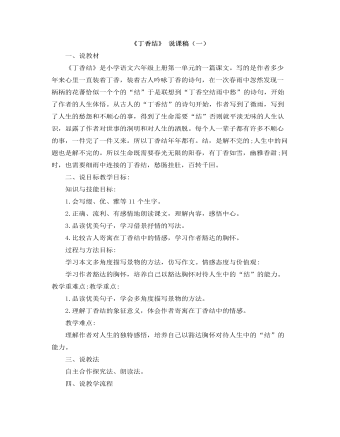
部编人教版六年级上册《丁香结》说课稿(一)
一、说教材《丁香结》是小学语文六年级上册第一单元的一篇课文。写的是作者多少年来心里一直装着丁香,装着古人吟咏丁香的诗句,在一次春雨中忽然发现一柄柄的花蕃恰似一个个的“结”于是联想到“丁香空结雨中愁”的诗句,开始了作者的人生体悟。从古人的“丁香结”的诗句开始,作者写到了微雨,写到了人生的愁怨和不顺心的事,得到了生命需要“结”否则就平淡无味的人生认识,显露了作者对世事的洞明和对人生的洒脱。每个人一辈子都有许多不顺心的事,一件完了一件又来。所以丁香结年年都有。结,是解不完的;人生中的问题也是解不完的。所以生命既需要春光无限的阳春,有丁香如雪,幽雅香甜;同时,也需要细雨中连接的丁香结,愁肠挂肚,百转千回。
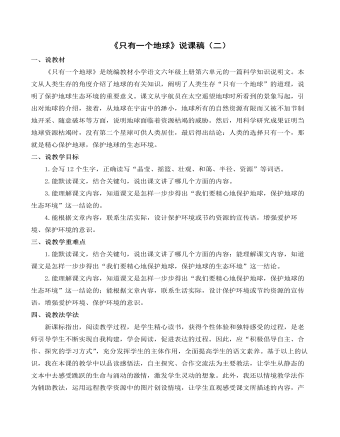
部编人教版六年级上册《只有一个地球》说课稿(二)
一、说教材 《只有一个地球》是统编教材小学语文六年级上册第六单元的一篇科学知识说明文。本文从人类生存的角度介绍了地球的有关知识,阐明了人类生存“只有一个地球”的道理,说明了保护地球生态环境的重要意义。课文从宇航员在太空遥望地球时所看到的景象写起,引出对地球的介绍,接着,从地球在宇宙中的渺小,地球所有的自然资源有限而又被不加节制地开采、随意破坏等方面,说明地球面临着资源枯竭的威胁。然后,用科学研究成果证明当地球资源枯竭时,没有第二个星球可供人类居住,最后得出结论:人类的选择只有一个,那就是精心保护地球,保护地球的生态环境。二、说教学目标 1.会写12个生字,正确读写“晶莹、摇篮、壮观、和蔼、半径、资源”等词语。 2.能默读课文,结合关键句,说出课文讲了哪几个方面的内容。 3.能理解课文内容,知道课文是怎样一步步得出“我们要精心地保护地球,保护地球的生态环境”这一结论的。
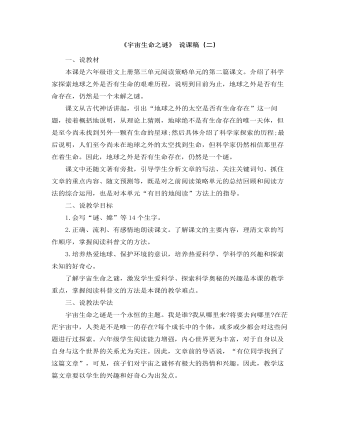
部编人教版六年级上册《宇宙生命之谜》说课稿(二)
三、说教法学法宇宙生命之谜是一个永恒的主题。我是谁?我从哪里来?将要去向哪里?在茫茫宇宙中,人类是不是唯一的存在?每个成长中的个体,或多或少都会对这些问题进行过探索。六年级学生阅读能力增强,内心世界更为丰富,对于自身以及自身与这个世界的关系尤为关注。因此,文章前的导语说,“有位同学找到了这篇文章”,可见,孩子们对宇宙之谜怀有极大的热情和兴趣。因此,教学这篇文章要以学生的兴趣和好奇心为出发点。《语文课程标准》明确指出:“积极倡导自主、合作、探究的学习方式”,要充分发挥学生的主体作用,全面提高学生的语文素养。基于以上认识,我主要采用以读为主,读思议相结合以及引扶放相结合的方法,引入恰当的游戏教学,让学生在把握内容的基础上探究理解,辩论解疑,而教师引导流程,放手让学生自学、探究,点拨重难点,充分发挥学生的主体作用。

部编人教版六年级上册《古诗三首》说课稿
二、说教学目标 1.读准多音字“曲”,会写2个生字。 2.有感情地朗读课文,背诵课文,默写《江南春》。 3.能结合注释,用自己的话说出诗句的意思,读懂诗歌大意。 4.能说出《浪淘沙》是怎样写出黄河的雄伟气势的。 5.能感悟《江南春》是抓住了哪些景物写出了江南春天的特点的。 6.结合诗句,初步感受古诗中的对偶句。 三、说教学重难点1.有感情地朗读课文,背诵课文,默写《江南春》;能理解诗歌大意,体会诗歌写法;结合诗句,初步感受古诗中的对偶句。2.能理解诗歌大意,体会诗歌写法;结合诗句,初步感受古诗中的对偶句。3.想象诗歌描绘的祖国大好河山的壮丽景色,体会诗人的情感。四、说教法学法 教学中采用“创设情境入诗境——想象画面解诗意——吟诵诗词品情感”的教学方法,注重图文结合,抓字眼、抓想象、抓吟诵。体现《语文课程标准》“以读为本”的理念,让朗读贯穿整个教学过程。在读中感受古诗优美精湛的语言文字和丰富的人文内涵,在读中引领学生入情入境,在读中有所感悟,在读中受到情感的熏陶。
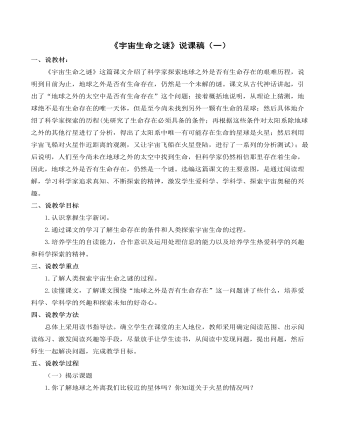
部编人教版六年级上册《宇宙生命之谜》说课稿(一)
一、说教材: 《宇宙生命之谜》这篇课文介绍了科学家探索地球之外是否有生命存在的艰难历程,说明到目前为止,地球之外是否有生命存在,仍然是一个未解的谜。课文从古代神话讲起,引出了“地球之外的太空中是否有生命存在”这个问题;接着概括地说明,从理论上猜测,地球绝不是有生命存在的唯一天体,但是至今尚未找到另外一颗有生命的星球;然后具体地介绍了科学家探索的历程(先研究了生命存在必须具备的条件;再根据这些条件对太阳系除地球之外的其他行星进行了分析,得出了太阳系中唯一有可能存在生命的星球是火星;然后利用宇宙飞船对火星作近距离的观测,又让宇宙飞船在火星登陆,进行了一系列的分析测试);最后说明,人们至今尚未在地球之外的太空中找到生命,但科学家仍然相信那里存在着生命,因此,地球之外是否有生命存在,仍然是一个谜。选编这篇课文的主要意图,是通过阅读理解,学习科学家追求真知、不断探索的精神,激发学生爱科学、学科学、探索宇宙奥秘的兴趣。

部编人教版六年级上册《古诗三首:浪淘沙》 说课稿
一、说教材《浪淘沙》是六年级语文上册第六单元中的一首古诗,这是一首描写黄河雄伟气势的著名诗篇。诗开篇与众多的黄河诗一样,着力描写九曲黄河大浪淘沙之势。紧接着著张骞穷河源遇牛郎、织女的典故,再把“黄河之水天上来”更形象化。在王之涣、李白之外,另辟一条境界,增添了一层奇妙的神话色彩。全诗立意新颖,思想深刻,明快清新。表现了诗人奋发有力的精神和豪迈浪漫的气魄。二、说学情学生在经过了五年的语文学习后,已经形成了一定的诗歌的学习方法和学习步骤,能通过资料以及对背景的了解对诗歌的大意进行自学理解。但同时,学生还存在理解诗歌有时不够深入,缺乏自己的思考过程,特别是在体悟诗歌情境上有着明显的不足。因此,教师在教学中应着力培养学生联系上下文赏析诗歌的意识和习惯的同时,需帮助学生在头脑中更好的建构起诗中情境画面,让学生由诗句产生丰富的联想,体会诗歌的意象美。
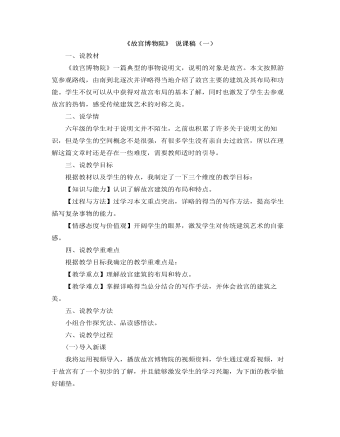
部编人教版六年级上册《故宫博物院》说课稿(一)
一、说教材《故宫博物院》一篇典型的事物说明文,说明的对象是故宫。本文按照游览参观路线,由南到北逐次并详略得当地介绍了故宫主要的建筑及其布局和功能。学生不仅可以从中获得对故宫布局的基本了解,同时也激发了学生去参观故宫的热情,感受传统建筑艺术的对称之美。二、说学情六年级的学生对于说明文并不陌生,之前也积累了许多关于说明文的知识,但是学生的空间概念不是很强,有很多学生没有亲自去过故宫,所以在理解这篇文章时还是存在一些难度,需要教师适时的引导。三、说教学目标根据教材以及学生的特点,我制定了一下三个维度的教学目标:【知识与能力】认识了解故宫建筑的布局和特点。【过程与方法】过学习本文重点突出,详略的得当的写作方法,提高学生描写复杂事物的能力。【情感态度与价值观】开阔学生的眼界,激发学生对传统建筑艺术的自豪感。
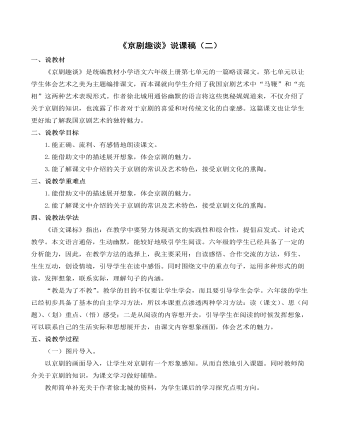
部编人教版六年级上册《京剧趣谈》说课稿(二)
一、说教材《京剧趣谈》是统编教材小学语文六年级上册第七单元的一篇略读课文。第七单元以让学生体会艺术之美为主题编排课文,而本课就向学生介绍了我国京剧艺术中“马鞭”和“亮相”这两种艺术表现形式。作者徐北城用通俗幽默的语言将这些奥秘娓娓道来,不仅介绍了关于京剧的知识,也流露了作者对于京剧的喜爱和对传统文化的自豪感。这篇课文也让学生更好地了解我国京剧艺术的独特魅力。二、说教学目标 1.能正确、流利、有感情地朗读课文。 2.能借助文中的描述展开想象,体会京剧的魅力。 3.能了解课文中介绍的关于京剧的常识及艺术特色,接受京剧文化的熏陶。三、说教学重难点1.能借助文中的描述展开想象,体会京剧的魅力。2.能了解课文中介绍的关于京剧的常识及艺术特色,接受京剧文化的熏陶。
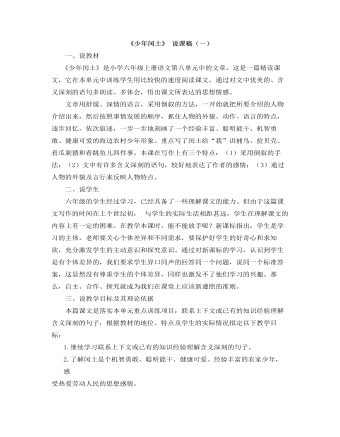
部编人教版六年级上册《少年闰土》说课稿(一)
一、说教材 《少年闰土》是小学六年级上册语文第八单元中的文章。这是一篇精读课文,它在本单元中训练学生用比较快的速度阅读课文,通过对文中优美的、含义深刻的语句多朗读、多体会,悟出课文所表达的思想情感。文章用舒缓、深情的语言,采用倒叙的方法,一开始就把所要介绍的人物介绍出来,然后按照事情发展的顺序,抓住人物的外貌、动作、语言的特点,逐步回忆,依次叙述,一步一步地刻画了一个经验丰富、聪明能干、机智勇敢、健康可爱的海边农村少年形象。重点写了闰土给“我”讲捕鸟、捡贝壳、看瓜刺猹和看跳鱼儿四件事。本课在写作上有三个特点:(1)采用倒叙的手法:(2)文中有许多含义深刻的语句,较好地表达了作者的感情;(3)通过人物的外貌及言行来反映人物特点。

部编人教版六年级上册《七律 · 长征》说课稿
一、说教材《七律·长征》是统编教材小学语文六年级上册第二单元的一篇课文,本课是毛泽东主席在1935年10月,长征即将胜利之时,回想起红军所走过的千山万水,所经历的艰难坎坷,心情激动地写下了这首诗。这首诗生动地概述了红军两万五千里长征的艰难历程,讴歌了中国工农红军在长征途中所表现出的 革命英雄主义气和革命乐观主义精神。 课标对高年级诗歌阅读提出明确要求:“阅读诗歌,大体把握诗意,想象诗歌描述的情境,体会诗人的情感。受到优秀作品的感染和激励,向往和追求美好的理想。”为此,我将本课的教学目标确定如下: 二、说教学目标: (1)知识与能力目标:能正确、流利、有感情地朗读课文,背诵课文,并学习生字,积累词语。 (2)过程与方法目标:借助多媒体课件等资源,创设情境,引领学生自主探究,互动交流,在读中理解,读中感悟。 (3)情感态度与价值观目标:体会红军大无畏的英雄气概和革命乐观主义精神。
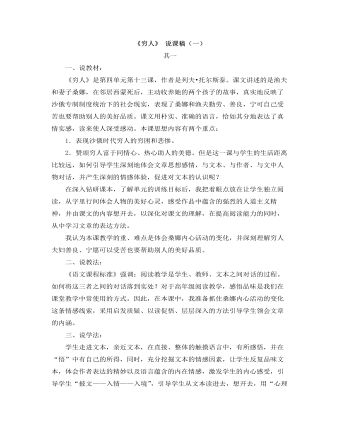
部编人教版六年级上册《穷人》说课稿(一)
四、说教学过程:我准备分两课时来完成本课的教学。现在着重说说第一课时,在这一课时里,主要引导学生初读课文,自学字词,了解课文的主要内容。通过学习,学生了解到文章讲的是渔夫和妻子桑娜(板书)在邻居西蒙死后,主动收养西蒙的两个孩子的事。抓住重点语句细读深思、用心感悟。在理解内容的基础上,把握文章的中心,体会穷人的美好心灵。体会他们的善良、乐于助人的美好品质。这样,学生就能由浅入深,由表及里地探究课文,使教路、学路、文路和谐统一,同步进行,从而培养学生多方面的语文能力,实现教师、学生、文本之间的对话。我设计了这样的结束语:“选择责任,选择实践良知,这是最重要的东西。选择爱,主动给别人爱,就会有意想不到的收获!”
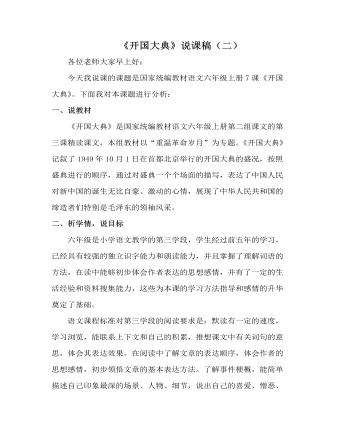
部编人教版六年级上册《开国大典》说课稿(二)
一、说教材《开国大典》是国家统编教材语文六年级上册第二组课文的第三课精读课文,本组教材以“重温革命岁月”为专题。《开国大典》记叙了1949年10月1日在首都北京举行的开国大典的盛况,按照盛典进行的顺序,通过对盛典一个个场面的描写,表达了中国人民对新中国的诞生无比自豪、激动的心情,展现了中华人民共和国的缔造者们特别是毛泽东的领袖风采。二、析学情,说目标六年级是小学语文教学的第三学段,学生经过前五年的学习,已经具有较强的独立识字能力和朗读能力,并且掌握了理解词语的方法,在读中能够初步体会作者表达的思想感情,并有了一定的生活经验和资料搜集能力,这些为本课的学习方法指导和感情的升华奠定了基础。
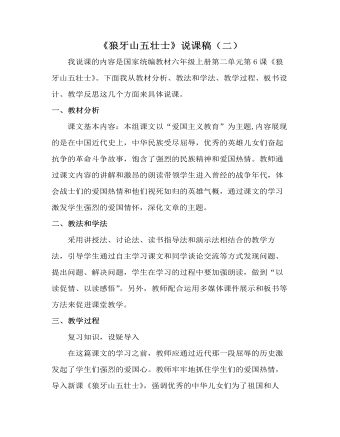
部编人教版六年级上册《狼牙山五壮士》说课稿(二)
一、教材分析课文基本内容:本组课文以“爱国主义教育”为主题,内容展现的是在中国近代史上,中华民族受尽屈辱,优秀的英雄儿女们奋起抗争的革命斗争故事,饱含了强烈的民族精神和爱国热情。教师通过课文内容的讲解和激昂的朗读带领学生进入曾经的战争年代,体会战士们的爱国热情和他们视死如归的英雄气概,通过课文的学习激发学生强烈的爱国情怀,深化文章的主题。二、教法和学法采用讲授法、讨论法、读书指导法和演示法相结合的教学方法,引导学生通过自主学习课文和同学谈论交流等方式发现问题、提出问题、解决问题,学生在学习的过程中要加强朗读,做到“以读促情、以读感悟”。另外,教师配合运用多媒体课件展示和板书等方法来促进课堂教学。
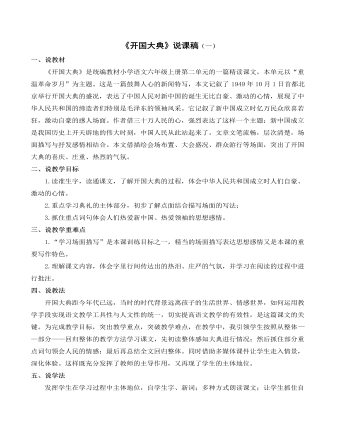
部编人教版六年级上册《开国大典》说课稿(一)
四、说教法 开国大典距今年代已远,当时的时代背景远离孩子的生活世界、情感世界,如何运用教学手段实现语文教学工具性与人文性的统一,切实提高语文教学的有效性,是这篇课文的关键。为完成教学目标,突出教学重点,突破教学难点,在教学中,我引领学生按照从整体——部分——回归整体的教学方法学习课文,先初读整体感知大典进行情况;然后抓住部分重点词句领会人民的情感;最后再总结全文回归整体。同时借助多媒体课件让学生走入情景,深化体验。这样既充分发挥了教师的主导作用,又再现了学生的主体地位。 五、说学法 发挥学生在学习过程中主体地位,自学生字、新词;多种方式朗读课文;让学生抓住自己感兴趣的场景,朗读,想象,谈体会,即通过谈——读——想——体这四个环节,来学习课文,这样既培养了学生的自学能力,又充分发挥了学生的想象力,让学生有效地展开了与文本的对话。
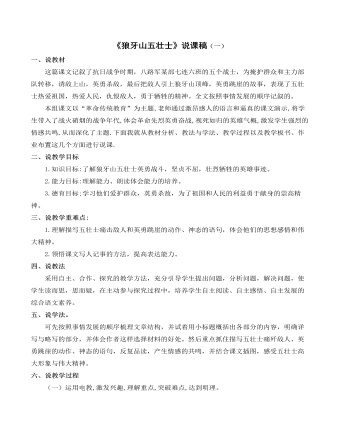
部编人教版六年级上册《狼牙山五壮士》说课稿(一)
一、说教材这篇课文记叙了抗日战争时期,八路军某部七连六班的五个战士,为掩护群众和主力部队转移,诱敌上山,英勇杀敌,最后把敌人引上狼牙山顶峰,英勇跳崖的故事,表现了五壮士热爱祖国,热爱人民,仇恨敌人,勇于牺牲的精神。全文按照事情发展的顺序记叙的。本组课文以“革命传统教育”为主题,老师通过激昂感人的语言和逼真的课文演示,将学生带入了战火硝烟的战争年代,体会革命先烈英勇奋战,视死如归的英雄气概,激发学生强烈的情感共鸣,从而深化了主题.下面我就从教材分析、教法与学法、教学过程以及教学板书、作业布置这几个方面进行说课.二、说教学目标1.知识目标:了解狼牙山五壮士英勇战斗,坚贞不屈,壮烈牺牲的英雄事迹。2.能力目标:理解能力、朗读体会能力的培养。3.德育目标;学习他们爱护群众,英勇杀敌,为了祖国和人民的利益勇于献身的崇高精神。
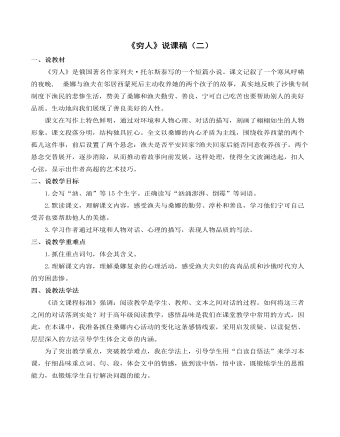
部编人教版六年级上册《穷人》说课稿(二)
三、说教学重难点1.抓住重点词句,体会其含义。2.理解课文内容,理解桑娜复杂的心理活动,感受渔夫夫妇的高尚品质和沙俄时代穷人的穷困悲惨。 四、说教法学法 《语文课程标准》强调:阅读教学是学生、教师、文本之间对话的过程。如何将这三者之间的对话落到实处?对于高年级阅读教学,感悟品味是我们在课堂教学中常用的方式。因此,在本课中,我准备抓住桑娜内心活动的变化这条感情线索,采用启发质疑、以读促悟、层层深入的方法引导学生体会文章的内涵。 为了突出教学重点,突破教学难点,我在学法上,引导学生用“自读自悟法”来学习本课,仔细品味重点词、句、段,体会文中的情感,做到读中悟,悟中读,既锻炼学生的思维能力,也锻炼学生自行解决问题的能力。
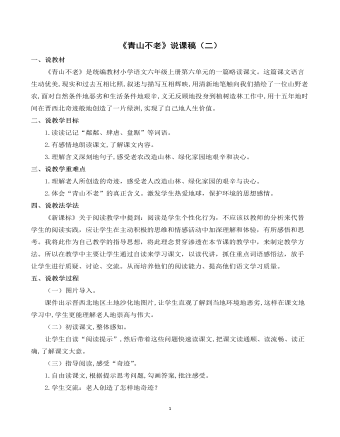
部编人教版六年级上册《青山不老》说课稿(二)
一、说教材 《青山不老》是统编教材小学语文六年级上册第六单元的一篇略读课文。这篇课文语言生动优美,现实和过去互相比照,叙述与描写互相辉映,用清新地笔触向我们描绘了一位山野老农,面对自然条件地恶劣和生活条件地艰辛,义无反顾地投身到植树造林工作中,用十五年地时间在晋西北奇迹般地创造了一片绿洲,实现了自己地人生价值。 二、说教学目标 1.读读记记“粼粼、肆虐、盘踞”等词语。 2.有感情地朗读课文,了解课文内容。 3.理解含义深刻地句子,感受老农改造山林、绿化家园地艰辛和决心。 三、说教学重难点1.理解老人所创造的奇迹,感受老人改造山林、绿化家园的艰辛与决心。 2.体会“青山不老”的真正含义。激发学生热爱地球,保护环境的思想感情。
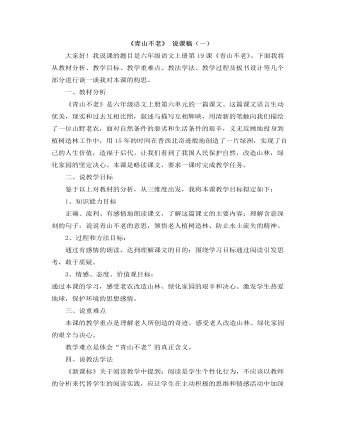
部编人教版六年级上册《青山不老》说课稿(一)
大家好!我说课的题目是六年级语文上册第19课《青山不老》。下面我将从教材分析、教学目标、教学重难点、教法学法、教学过程及板书设计等几个部分进行谈一谈我对本课的构思。一、教材分析 《青山不老》是六年级语文上册第六单元的一篇课文。这篇课文语言生动优美,现实和过去互相比照,叙述与描写互相辉映,用清新的笔触向我们描绘了一位山野老农,面对自然条件的恶劣和生活条件的艰辛,义无反顾地投身到植树造林工作中,用15年的时间在晋西北奇迹般地创造了一片绿洲,实现了自己的人生价值,造福于后代。让我们看到了我国人民保护自然,改造山林,绿化家园的坚定决心。本课是略读课文,要求一课时完成教学任务。
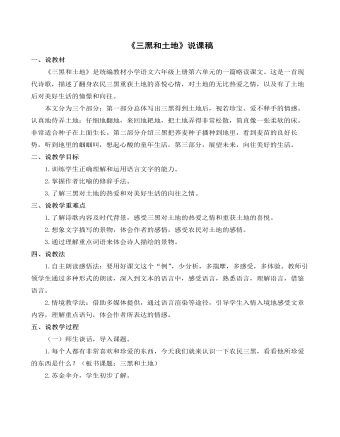
部编人教版六年级上册《三黑和土地》说课稿
一、说教材 《三黑和土地》是统编教材小学语文六年级上册第六单元的一篇略读课文。这是一首现代诗歌,描述了翻身农民三黑重获土地的喜悦心情,对土地的无比热爱之情,以及有了土地后对美好生活的憧憬和向往。 本文分为三个部分:第一部分总体写出三黑得到土地后,视若珍宝、爱不释手的情感。认真地侍弄土地:仔细地翻地,来回地耙地,把土地弄得非常松散,简直像一张柔软的床。非常适合种子在上面生长。第二部分介绍三黑把荞麦种子播种到地里,看到麦苗的良好长势,听到地里的蝈蝈叫,想起心酸的童年生活,第三部分,展望未来,向往美好的生活。 二、说教学目标 1.训练学生正确理解和运用语言文字的能力。 2.掌握作者比喻的修辞手法。 3.了解三黑对土地的热爱和对美好生活的向往之情。
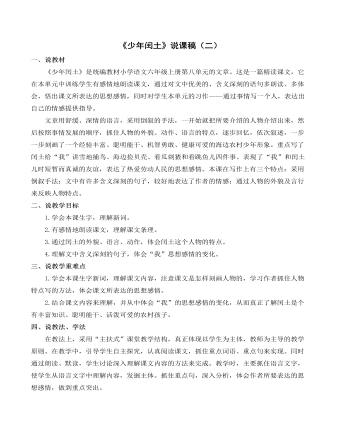
部编人教版六年级上册《少年闰土》说课稿(二)
二、说教学目标 1.学会本课生字,理解新词。 2.有感情地朗读课文,理解课文条理。 3.通过闰土的外貌、语言、动作,体会闰土这个人物的特点。4.理解文中含义深刻的句子,体会“我”思想感情的变化。 三、说教学重难点 1.学会本课生字新词,理解课文内容,注意课文是怎样刻画人物的,学习作者抓住人物特点写的方法,体会课文所表达的思想感情。 2.结合课文内容来理解,并从中体会“我”的思想感情的变化,从而真正了解闰土是个有丰富知识、聪明能干、活泼可爱的农村孩子。四、说教法、学法在教法上,采用“主扶式”课堂教学结构,真正体现以学生为主体,教师为主导的教学原则。在教学中,引导学生自主探究,认真阅读课文,抓住重点词语、重点句来实现。同时通过朗读、默读,学生讨论深入理解课文内容的方法来完成。教学时,主要抓住语言文字,使学生从语言文字中理解内容,发掘主体。抓住重点句,深入分析,体会作者所要表达的思想感情,做到重点突出。

